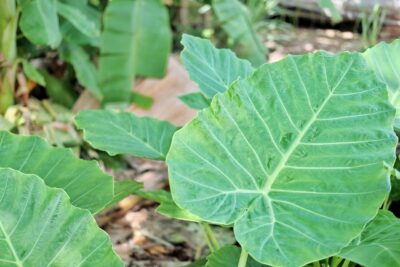
Giant elephant ear
The giant elephant ear, is a large perennial plant native to Southeast Asia. It features broad, heart-shaped leaves and thick leaf stalks. The plant is valued for its ornamental appeal and thrives in tropical climates. While the corms and leaf stalks are consumed as vegetables, it is mainly grown for its striking appearance in gardens.
Names
Scientific
Leucocasia gigantea
Synonym
Colocasia gigantea
English
Giant elephant ear
Indian taro
Taxonomy
Order
Alismatales
Family
Araceae
Genus
Leucocasia
Species
Leucocasia gigantea (Giant elephant ear)
Basic information and facts
Origin:
Native to Southeast Asia, particularly tropical regions like Thailand and Malaysia.
Distribution:
Found throughout tropical and subtropical climates, often cultivated in gardens and farms across Southeast Asia, and occasionally in other tropical regions worldwide.
Annual, biennial, or perennial:
Perennial.
Flowers:
The plant produces small, inconspicuous flowers in a spadix-and-spathe arrangement, typical of the Araceae family. These are not often noticed due to the large foliage.
Leaves:
Large, heart-shaped leaves that can grow up to 1.5 meters (5 feet) long, with a glossy green color and a prominent midrib.
Fruits:
Fruits are small, orange berries that contain seeds, but the plant is generally grown for its foliage and edible corms rather than for its fruits.
Climate and weather:
Prefers warm, humid tropical climates with consistent rainfall and temperatures between 20°C and 30°C (68°F to 86°F).
Pollination:
The plant is primarily pollinated by insects, though it is more commonly propagated vegetatively than by seed.
Height:
Can grow up to 2-3 meters (6-10 feet) tall, depending on environmental conditions.
Spacing:
Typically spaced 1 to 1.5 meters (3 to 5 feet) apart to allow for proper growth of its large leaves.
Propagation:
Primarily propagated through offsets or corm division, though it can also be grown from seeds.
Insect pests:
Common pests include aphids, mealybugs, and spider mites.
Diseases:
Prone to root rot, especially in overly wet or poorly-drained soils. Fungal infections and bacterial wilt may also occur.
Harvesting:
Harvest the corms and leaf stalks when they are mature. The corms are typically harvested after 6-12 months, while the leaf stalks can be cut and used as needed.
Uses:
Grown for ornamental purposes due to its striking appearance. The corms and leaf stalks are edible and used in cooking, often in soups, stews, and stir-fries. The plant is also used in traditional medicine in some cultures.
Crop categories
Minor crops
Root vegetables
Stem vegetables
Tropical crops
Vegetables
